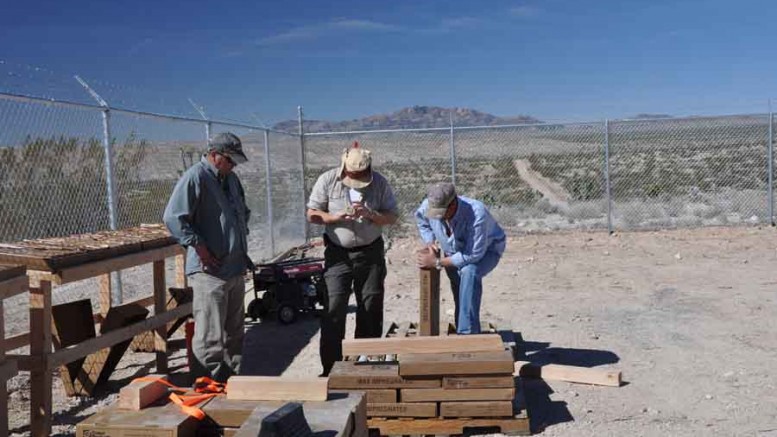Research analysts Joe Mazumdar and Scott McLean of Canaccord Genuity in Vancouver have raised their target price on Castle Mountain Mining (TSXV: CMM) to $1 per share and added the company to the Canaccord Genuity Focus List, after the development-stage mining company released its first resource estimate on the Castle Mountain gold project in southern California.
The open-pit, heap-leach gold project in San Bernardino County, 90 km south of Las Vegas, “represents a ‘bolt-on’ asset for an intermediate gold producer,” they pen in a research note, putting a potential takeover price at $1.74 per share — 170% higher than Castle Mountain’s 60¢ share price on the TSX Venture Exchange.
The Castle Mountain mine shut down because of low gold prices in 2002, and the company hopes to reactivate it after completing a feasibility study before the end of 2014. A second drilling phase is proposed to start early next year.
The project already has a mining permit that was recently extended by five years to Dec. 31, 2025. The permit allows for mining of up to 9 million tons (8.2 million tonnes) of ore per year and includes on-site heap leaching, and there are no pit-backfill requirements.
In the meantime, Castle Mountain has defined its first resource estimate, based on 1,762 holes of historical drilling and 8,368 metres of its own drilling in 30 reverse-circulation and core holes.
Indicated resources tally 165.1 million tonnes grading an average 0.60 gram gold per tonne for 3.15 million contained oz. gold, while inferred resources add 57.8 million tonnes of 0.57 gram gold per tonne for 1.06 million contained oz. gold.
The resource estimate was based on a cut-off grade of 0.14 gram gold per tonne, and contained within a Whittle pit shell using a US$1,300 per oz. gold price. The company noted that the National Instrument 43-101-compliant resource reconciles to within 5% of the data collected through historic mining operations.
Company chairman Robert Buchan — who founded Kinross Gold (TSX: K; NYSE: KGC) in 1993, and was one of the founders of Katanga Mining (TSX: KAT) — noted in a press release that the size, grade, pervasive oxidation and full mining permit “position Castle Mountain amongst the very best development assets in North America.”
The heap-leach gold mine produced more than 1 million oz. gold between 1992 and 2002. The principal gold mineralization Castle Mountain has identified so far within the project area lies below and surrounding the historically mined pits, including the Oro Belle–Hart Tunnel, Jumbo and Lesley Anne–Jumbo South pits and the South Domes area.
Castle Mountain mineralization is hosted in a sequence of Miocene rhyolite domes, flows and associated sedimentary units. The hydrothermal system is typical of other low-sulphidation gold deposits within the adjacent Great Basin. The deposit has fine-grained gold and electrum that occurs disseminated in quartz–stockwork veins, brecciated rhyolite domes, shear zones and silicified volcanic and sedimentary rocks.
The project is accessible by road year-round.
Over the last year Castle Mountain has traded between 20¢ and 68¢, and has 53 million shares outstanding.
Michael Siperco and Valeriy Dolgopolov of Macquarie Securities initiated coverage on Castle Mountain on Nov. 25, with a price target of $2 per share and a recommendation to buy the stock ahead of the company’s phase-two drill program. It will advance its feasibility study in 2014.
The mining analysts point to Castle Mountain’s “solid corporate team” — led by CEO Gordon McCreary, a mining engineer who previously co-founded and developed Baffinland Iron Mines — and the company’s “growing technical team on the ground.”
Siperco and Dolgopolov see little permitting risk, and after contacting local officials, feel confident that the government supports the project. The city of San Bernardino declared bankruptcy in 2012, they write, and the county “is anxious to develop additional sources of employment and tax revenue.”
The analysts anticipate construction in early 2015 and initial production in early 2016, reaching full capacity in 2017. And given the larger-than-expected maiden resource, they say they “do not believe that management will need to release a separate preliminary economic study, but one could be produced in the first half of 2014, as part of the feasibility study work.”
Based on similar projects, the pair forecast total construction capital expenditures of $100 million for a 15,000-tonne-per-day, three-stage crushing operation, and argue the project “works at lower gold prices and has more upside potential in an expansion scenario.”


Be the first to comment on "Castle Mountain completes maiden resource"